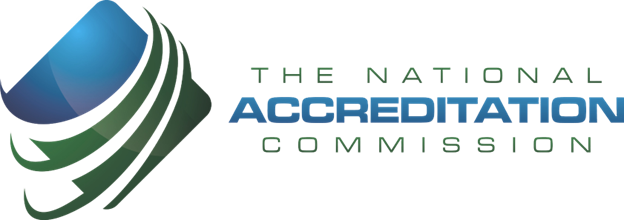The Critical Challenge
America's workforce training ecosystem faces a fundamental gap: while traditional accreditation serves credit bearing and degree programs effectively, the rapidly expanding noncredit sector—serving millions of learners annually—operates without standardized quality assurance. This "missing middle" undermines employer confidence, limits funding eligibility, and leaves learners vulnerable to substandard training programs that fail to deliver promised career outcomes. Plus, with Workforce Pell enacted on July 1, 2026 and expanding federal financial aid to short-term workforce training programs, NAC stands ready to help prepare training providers with robust quality assurance mechanisms.
NAC’s Breakthrough Solution
The National Accreditation Commission (NAC) is pioneering the first AI-powered programmatic accreditation system specifically designed for noncredit workforce training. Our revolutionary AIHub platform combines cutting-edge artificial intelligence with a human in the end to evaluate, monitor, and verify program quality at unprecedented scale and precision.
Immediate Impact Across the Ecosystem
- State and Federal Agencies gain unprecedented assurance that workforce investments target high-quality, scalable programs that deliver measurable results.
- Institutional Accreditors leverage AIHub’s data innovations and advanced technologies to transform their understanding and unlock critical insights into noncredit programs.
- Learners access verified training pathways that are affordable, stackable, and lead to better employment outcomes.
- Employers can confidently recruit from programs that consistently develop in-demand skills aligned to their specific workforce needs.
- Training Providers unlock funding opportunities and leverage programmatic analytics to maximize impact and improve outcomes.
Real-World Success: Arkansas Partnership
Arkansas exemplifies NAC’s transformative potential. Through our partnership we built a Tiered Quality Assurance Blueprint, for agile learning pathways that serve providers, employers, returning learners, veterans, and workers preparing for federal policy shifts like Workforce Pell expansion. Our “push model” proactively provides structured labor market data, ensuring perfect alignment between training programs and state economic priorities while creating clear on-ramps for programs to achieve higher quality standards.
Moreover, our strategic partnership with the Coleridge Initiative is revolutionizing this work, enabling us to build the AIHub within Arkansas’s secure state environment. This collaboration ensures that our AI-powered quality assurance platform meets the highest standards for data security and privacy while delivering unprecedented analytical capabilities for training evaluation.
Building Tomorrow’s Workforce Infrastructure
NAC’s groundbreaking model is attracting visionary partners across the nation. We collaborate with premier foundations, data science leaders, and education innovators to scale evidence-based solutions that bridge the gap between workforce training and economic opportunity. Together, we’re creating the national infrastructure needed to ensure every training program delivers measurable value to learners, employers, and communities.
We are actively engaged in strategic partnerships with organizations like the Coleridge Initiative—a nonprofit that empowers government agencies to use data more effectively through its secure, FedRAMP-certified ADRF platform. Their expertise in linking confidential data across states and agencies, combined with robust data literacy training, aligns with NAC’s mission to build strong data infrastructure for workforce education quality assurance. The ADRF will also enable NAC to assess job placement outcomes and wage gains, providing clear insight into the real-world impact of workforce programs.
The Strategic Imperative
NAC bridges critical policy and funding gaps that have constrained noncredit program impact for decades. Our recognition framework opens doors to public funding streams (WIOA, SNAP E&T, TANF, Workforce Pell), elevates programs in credential registries, builds employer confidence, and establishes seamless pathways to degree programs. We’re not just fixing today’s broken systems—we’re architecting the workforce education infrastructure of the future.
Tiered Quality Assurance Blueprint
| Level | QA Type | Review & Approval Timeframe | Primary Purpose | Funding Eligibility | Benefits for Providers | Benefits for Learners | Benefits for Employers |
|---|---|---|---|---|---|---|---|
| 1 | Informal | Less than 30 days | Curiosity-driven learning and personal development | Not eligible for public funding | Alignment with state economic development goals, access to learners | Exploration; self-paced; self-improvement; low risk | Skill and competency assessment aligned with Industry 4.0 |
| 2 | Approval-Based | 30-60 days Subject to WIB availability |
Compliance with education & workforce regulations, consumer protection | Eligible for WIOA if on ETPL; may qualify for state-funded grants and programs | Eligibility for ETPL; marketing access; baseline legitimacy | May qualify for tuition assistance (WIOA, SNAP E&T); basic quality assurance | Access to publicly subsidized training pipelines |
| 3 | Endorsed / Recognized | 30-180 days Subject to DOL & State Approval of RAPs |
Align with industry needs, signal labor market relevance | Often preferred or required for sector grants, Registered Apprenticeships, state innovation funds | Enhanced credibility; increased relevance; demand signal alignment | Greater confidence that training leads to a job | Identified, preferred talent signals for hiring and upskilling |
| 4 | Rubric-Based Quality Review | 60-180 days Peer Evaluation & Feedback Required |
Instructional quality, digital learning integrity, rapid-response credentials | Workforce Pell pilots, state quality designations, sometimes GI Bill or scholarship programs | Structured improvement feedback; stackability visibility; short-term Pell readiness | Higher-quality learning; clearer pathways; funding eligibility expanding | Confidence in instructional quality and skill development; higher retention |
| 5 | Noncredit Programmatic Accreditation | 60-180 days Site Visit and Commission Review Required |
Workforce-aligned programming, continuing education, micro credentials | Eligible for some federal programs (e.g., GI Bill, short-term Pell pilot), state or employer-funded programs | Leverage institutional infrastructure; credit articulation; branding value | Eligible for CPL; more recognized; better articulation into degrees or licenses | Consistent pipeline of work-ready, upskilled talent with known outcomes |
| 6 | Full Accreditation | Varies Subject to institutional accreditor timeframes |
Academic rigor, transferability, Title IV compliance | Eligible for Title IV (Pell, student loans), GI Bill, TAA, WIOA, Apprenticeships, etc. | Full financial aid access; brand and transfer value | Strong signaling power; transferable credit; maximum funding options | Highest trust and portability; used in regulated licensed occupations |
